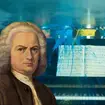Bach - Chorales: a guide
Bach's arrangements of hymn tunes found their way into cantatas, organ preludes, motets and other pieces. Find out more about them here.
A chorale is usually a simple and catchy melody to which a hymn is sung by soprano singers with a congregation, while the three lower voices provide the harmony. The church reformer Martin Luther (1483-1546) advocated the use of hymns sung in German during services and himself translated texts from Latin so that the people could understand them and participate. This created an immediate need for a large repertoire of new chorales. Luther wrote several, worked on their tunes, and helped publish them. Today, many of the Lutheran chorales are familiar as hymns used in Protestant churches, sung in four-voice harmony.
When he worked as an organist, J. S. Bach’s duties included accompanying congregational singing, and he was familiar with the Lutheran hymns. He included them in his church cantatas, typically as the closing chorale.
Bach's Chorale Cantatas
Chorales are used in some of Bach's earliest cantatas, although he usually incorporates them into just one or two movements. In his Passions, he often used chorales to complete a scene, as in this example from the St. Matthew Passion.
In Bach’s Chorale Cantatas, both text and music are based on one Lutheran hymn. In his second annual cycle in Leipzig, beginning with the first Sunday after Trinity 1724, he set out to compose a cantata for each occasion of the liturgical year. He began with O Ewigkeit, du Donnerwort and went on to compose forty chorale cantatas in that cycle until Palm Sunday of 1725.
Also termed the "chorale cantata year", the cycle has been called "the largest musical project that the composer ever undertook". In later years, Bach added several works for any occasions he had omitted during the year. The cantatas are based on hymns by a wide range of poets, from early reformers such as Luther to poets of the 17th century.
Bach's last newly composed chorale cantata in his second year in Leipzig was Wie schön leuchtet der Morgenstern for the feast of the Annunciation on 25 March.
Although there are no accounts of the reception given to Bach's chorale cantatas by the Leipzig congregration, it is known that some of these cantatas were the only works that the city was interested in keeping alive after Bach's death.
Bach's Chorale preludes
Chorales also appear in chorale preludes, pieces generally for organ designed to be played immediately before the congregational singing of the hymn. A chorale prelude includes the melody of the chorale, with added counterpoint.
Bach's many chorale preludes are the best-known examples of the form. The Great Eighteen Chorale Preludes are a set he prepared in Leipzig during his last decade, from earlier works composed in Weimar where he was court organist. These pieces, conceived on a large and often epic scale, have been described as the summit of Bach's sacred music for solo organ.
Chorale harmonizations
Chorale harmonizations can also be found in Bach's motets and in his Notebook for Anna Magdalena Bach. Almost all of the melodies of these chorales are not by Bach but go back to older sources.
The first record of the existence and sale of groups of collected chorale harmonizations and chorale melodies with figured bass extracted from larger works by J.S. Bach is from 1764, 14 years after Bach's death. In that year the firm Breitkopf und Sohn announced for sale manuscript copies of 150 chorale harmonizations and 240 chorale melodies with figured bass by J. S. Bach.


























